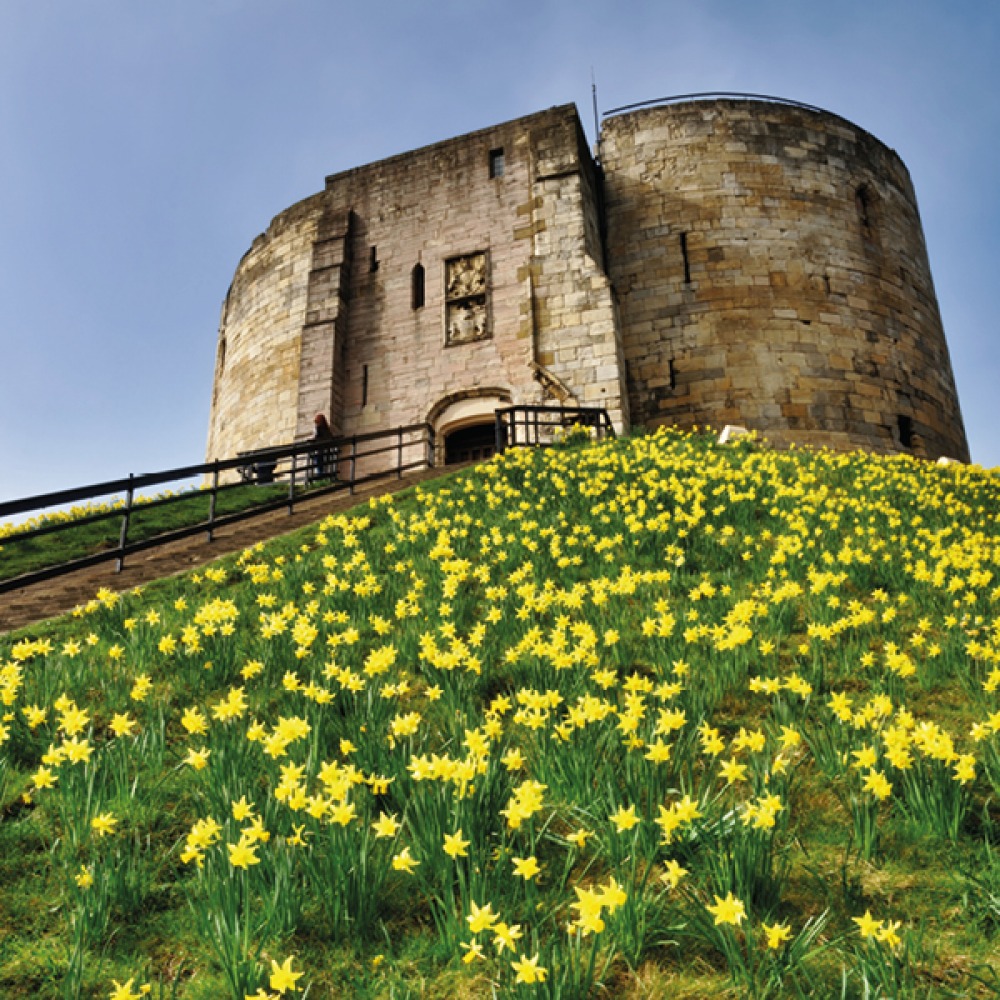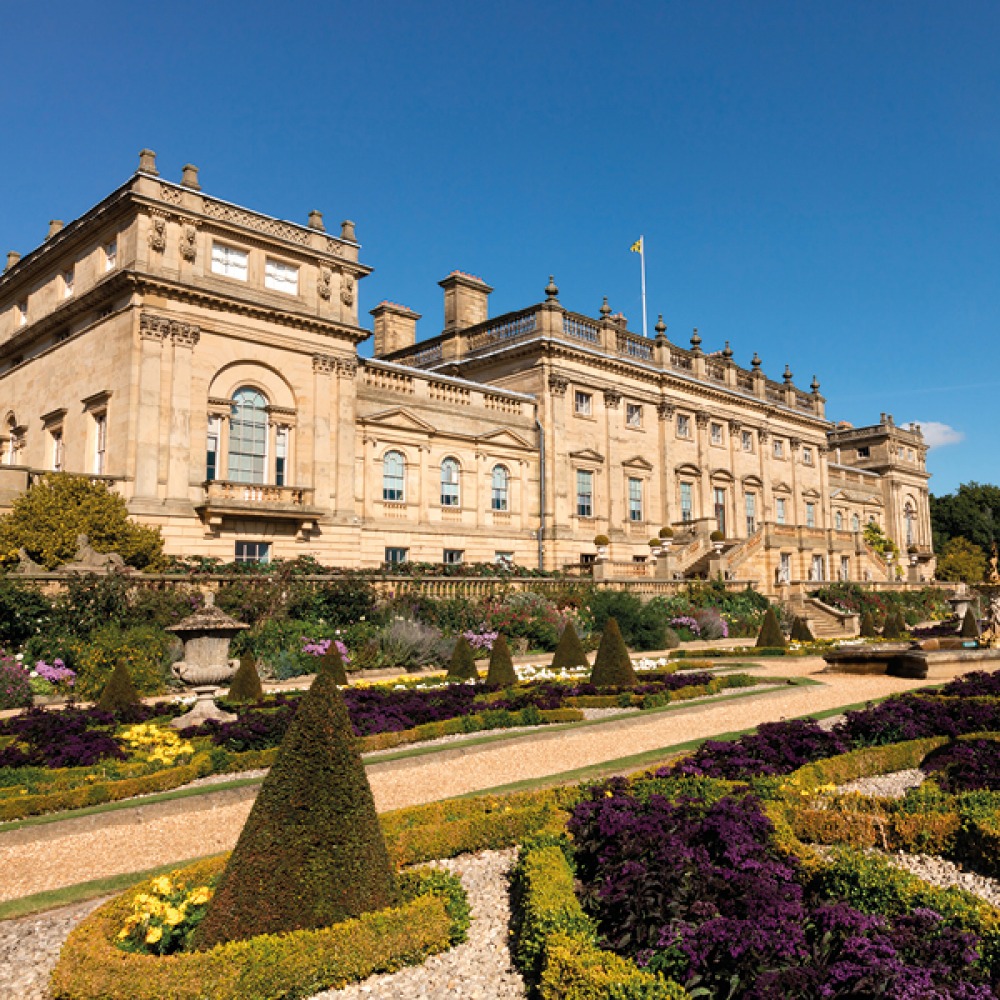The Coolest Cultural Hotspots in Yorkshire to Visit on World Heritage Day

In true celebration of World Heritage Day this April, we're highlighting some of Yorkshire's coolest cultural hotspots which you need to know about

Clifford’s Tower
The history of one of York’s most-loved landmarks starts with William the Conqueror who travelled north in 1068 to suppress a rebellion against him. William established a series of castles as he went, including one where Clifford’s Tower now stands.
In 1190, the 11th century timber tower on top of the earth mound was burned during an attack on York’s Jewish community. These were dark days for history as the community looked to Clifford’s Tower to seek refuge from violent mobs, but once trapped, many took to suicide over being murdered. Following restoration and rebuilding in the 14th and 15th centuries, the tower played a number of different roles, including as a treasury, an exchequer, a seat of royal power and a medieval stronghold. Now, as the principal surviving remnant of the York Castle, Clifford’s Tower is open to tourists and history buffs to learn more about its turbulent past.
Following a major £5 million conservation project, the previous empty shell now has a free-standing timber structure and new roof deck, allowing visitors to marvel at the fantastic views over the city of York. Inside the tower, explore the once lost first floor, where dramatic aerial walkways open up hidden rooms for the first time since the second fire in 1684, and tread the stairwells which have been opened to give visitors an understanding of the tower’s layout and structure. Take a seat on one of the tower’s new audio benches where you will be transported back to 1069, listening to dramatic stories of the uprising against the Normans, as well as the struggles it took to repair the tower after an explosion in the 17th century.
To find out how to book tickets to visit Clifford’s Tower, visit english-heritage.org.uk

Castle Howard
One of North Yorkshire’s most impressive stately homes, Castle Howard is set in 1,000 acres of parkland with statues, temples, lakes and fountains dotted around the estate. Eight generations of the Howard family have occupied the historic property, and through centuries of challenges and opportunities each have brought their own characteristics to the stewarding of the home and estate.
In the beginning, the third Earl of Carlisle, Charles Howard, enlisted the help of his friend Sir John Vanbrugh (despite having no experience) to build the extravagant home, and between 1699 and 1702 the design evolved. Building the home from east to west, the house took shape in less than 10 years. However by the time Sir John Vanbrugh passed away in 1726, the house was still incomplete, missing a west wing as focus had turned to the gardens. Finally completed in 1875, a series of restoration projects have been carried out, largely due to the fire in 1940 which caused the collapse of the great dome.
Now Castle Howard is open to the public with ever-evolving exhibitions showcasing the home’s rich and varied history. The grounds are open all year round, and when the house opens for the season on 1st April, visitors can explore the stories of those who walked the corridors, and discover hidden objects from the archives. Walk the breadth of the grounds which cover thousands of acres, including the tranquil Walled Garden which was laid out in the early 18th century as a kitchen garden and is still partly given over to vegetables and cut flowers. You’ll also be able to explore the numerous statues and waterways, including Castle Howard’s most recognisable sculpture, the Atlas Fountain which is visible from much of the house. We also recommend taking a look over the Temple of the Four Winds which was originally built for refreshments and reading, with a servant’s cellar underneath.
To book your tickets and to find out more about opening times, visit castlehoward.co.uk

Rievaulx Abbey
Marvel at the historic ruins of Rievaulx Abbey near Helmsley and reflect on the thousands of years of spiritual, commercial and Romantic history. Having recently undergone changes to the indoor museum, where unseen artefacts tell the tales of the dramatic rise and fall of the Cistercian abbey, there has never been a better time to visit.
Founded in 1130, Rievaulx was the first Cistercian abbey established in the North of England and quickly became one of the most powerful and spiritually renowned centres of monasticism in Britain. Under famous abbot Aelred, who had a reputation for being one of England’s most revered biblical scholars, the monastery grew. Long after Aelred’s death, the monastery was suppressed in 1538, however the ruins became popular once more during the Romantic period when Rievaulx Abbey was seen as a celebration for artists, painters and poets during the 18th and 19th centuries.
Now the spectacular ruins in the valley of the River Rye are open to all. Under English Heritage, the indoor museum holds the secrets of the medieval monastery’s rich past, showcasing artefacts from the abbey, including stone carvings and gold coins which tell the tales of the rise and fall of the first northern Cistercian abbey. During your visit you’ll also be able to take an audio tour to hear how monks devoted their time to religious matters and how they established one of Britain’s wealthiest monasteries.
To find out more, visit english-heritage.org.uk

Harewood House
Built in the 18th century, Edwin Lascelles wanted nothing but the best for his home, employing only the finest craftsman to carry out the work. York-born architect John Carr, interior designer Robert Adam and England’s greatest furniture maker, Thomas Chippendale, were just some of the great talents he employed. Taking the landscapes as seriously as the interiors, Edwin also commissioned visionary landscape gardener Lancelot ‘Capability’ Brown who crafted the landscape of more than 1,000 acres, as well as Sir Charles Barry, best known as the architect of the Houses of Parliament, who created Harewood House’s iconic Terrace Garden.
Today Harewood House is home to an impressive collection of paintings by masters of the Italian Renaissance, family portraits by Reynolds, Hopper and Lawrence, and modern art collected by the current Earl and Countess. As you wander around the house you’ll be able to explore the multitude of grand rooms including the old library, the state bedroom, the music room and the gallery. Outside, visitors can explore the grounds which are filled with a variety of plants from all over the world and where head gardener Trevor Nicholson, who oversees the award-winning landscapes, has created the naturalistic Himalayan Garden which boasts rare and exotic plants.
Not only is Harewood House and its beautiful grounds a fantastic place to explore, the Harewood farm is also a brilliant place for kids to learn more about the farm animals. Meet the friendly alpacas, the pot-bellied pigs and feed the pygmy goats before saying hello to the giant rabbits and guinea pigs.
Visit harewood.org to find out how to book tickets.

Scarborough Castle
Standing on a promontory of rock rising high above the North Sea, walk through the imposing gatehouse and explore the 3,000 years of history of Scarborough Castle. Although founded in the 12th century by William le Gros, Count of Aumâle, Scarborough Castle soon passed into the hands of the crown when Henry II demanded all royal castles, which included Scarborough, be given to the crown.
Throughout its history Scarborough Castle has played many different roles; and in 1159 Henry II began rebuilding the castle and a new town settlement beneath its walls. Later in the Middle Ages, Henry III maintained Scarborough Castle throughout his rein and it became known as one of the greatest royal fortresses in England.
Overlooking both North and South Bays, visitors can watch out for invaders in the North Sea from the ruins of the Roman signal station. Take a stroll around the perimeter of the 16-acre site before learning about the history which saw local gentleman, Sir Hugh Cholmley who was commissioned to hold Scarborough for Parliament in 1642, take on one of the bloodiest sieges of the Civil War, as well as how the castle served as a prison in the 1650s.
Hosting a number of events, including traditional Easter hunts and challenges, as well as knight tournaments and legendary jousting contests, Scarborough Castle is a fantastic place for the whole family to explore. Visitors can learn the story of Scarborough Castle though the Master Gunner’s House exhibition where a vast range of historic artefacts are on display, including tools and pottery from pre-historic times, as well as a magnificent replica of a Bronze Age sword found on site.
To find out more, visit english-heritage.org.uk

North Yorkshire Moors Railway
The Whitby to Pickering Railway was originally built as an attempt to halt the gradual decline of the port of Whitby because, until 1759 when the turnpike to Pickering opened, Whitby was better connected to the rest of the country by sea than it was by land. In 1836 the opening of the Whitby and Pickering railway meant a regular passenger service, however in 1965 the entire coastline railway closed following the infamous Beeching Report.
Wanting to see the Grosmont to Pickering line brought back to life, a small group of locals (later known as the North Yorkshire Moors Railway Preservation Society) obtained access to the line in 1967, with permission to run occasional Steam Galas where steam trains could run on the line, strictly for members only. As the society grew, it became a charity, and from just one individual in 1972, the numbers have grown to more than 550 volunteers.
Now the North Yorkshire Moors Railway invites visitors from the end of March to early November to hop on board and enjoy a fun-filled day of vintage charm and amazing scenery. The fleet of steam and heritage trains take you through 24 miles of National Park countryside from Pickering via Levisham to Newtondale Halt, Goathland and Grosmont, finishing at Whitby station.
Choose to ride the whole way, or stop off en-route – Pickering’s 1930s themed station will transport you back to the steam era, Levisham is surrounded by the natural beauty of the North York Moors and Goathland is famous for becoming Hogsmeade Station in the first Harry Potter film. A must-not-miss part of the railway is the Pullman Dining Train experience which celebrates its 50th anniversary this year. Enjoy an unforgettable dining experience where you’ll be transported back to the golden age of train travel as you ride through the beautiful North York Moors National Park all whilst enjoying a traditional afternoon tea.











